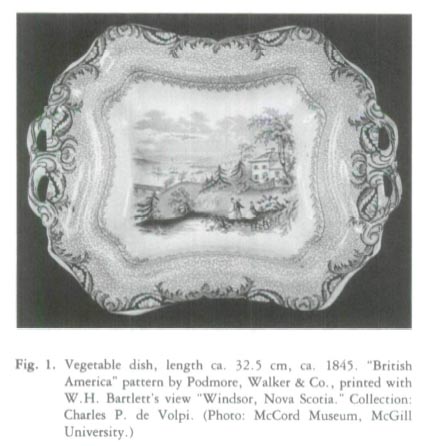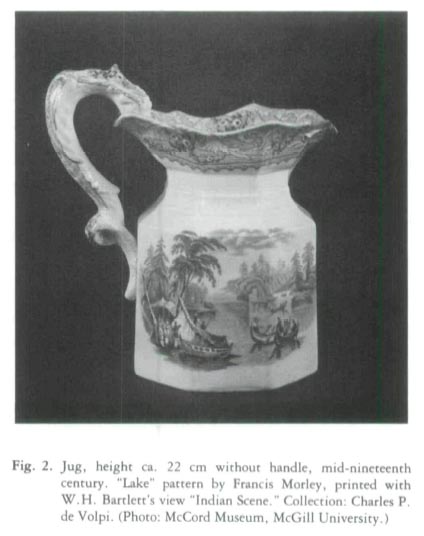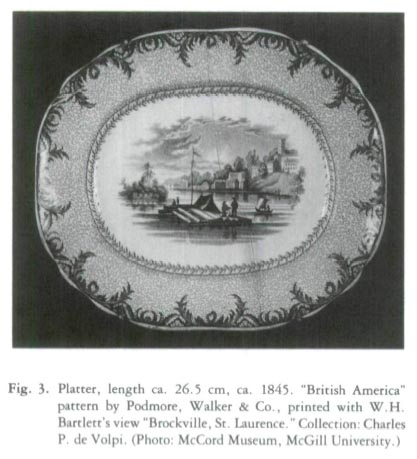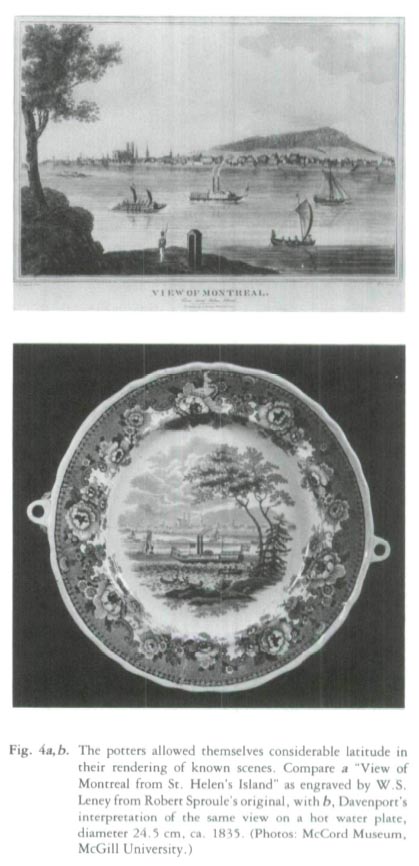Reviews / Comptes rendus
McCord Museum, "The Potters' View of Canada"
1 "The Potters' View of Canada" is an exhibition, the first major one of its kind, of nineteenth-century earthenware decorated with Canadian views. It has been timed to coincide with publication of the book of the same name by its guest curator, Elizabeth Collard. The benefits of Collard's comprehensive research and careful scholarship can be seen throughout the exhibition.
2 The exhibits begin with a concise introduction to the manufacturing and marketing of underglaze earthenware. The first panel is particularly appealing; it consists of illustrations taken from a booklet published in 1827 on the manufacture of earthenware. The marketing of ceramics is a recurring, but unstressed, note in the exhibition and the panel which first deals with this topic is an effective display of plates and platters against a backdrop of Canadian newspaper advertisements.
 Display large image of Figure 1
Display large image of Figure 13 The remainder, and the main part, of the exhibition explores all the known themes for Canadian views: famous figures, Cunard steamships, Arctic exploration, beavers, maple leaves, Canadian sports, and much picturesque scenery. Since one aim of the exhibition was to demonstrate changing tastes and perceptions throughout the nineteenth century, the themes are arranged more or less in chronological order, but the panels are not interdependent and can be viewed in any sequence.
4 One tenet of the guest curator is that ceramic objects (or indeed any artifact) can be appreciated from many viewpoints. It is this belief, as well as the breadth and depth of knowledge evident in the captions that elevates this exhibition beyond the level of an attractive collection of artifacts. A plate with a view of a William Bartlett scene, for example, is part of an unseen network among the artist, the printmaker, the publisher of a popular book of prints, dozens of workers in the pottery trade, the retailer, and, ultimately, the buyer. The captions collectively convey this rich point of view. Each caption is quite different; a text, rather than an identifying label. One caption may discuss the history of the firm making a certain pattern; another, the scene itself and what is now there; another, the importance of retailer's marks in dating ceramics.
5 The ceramics themselves form an impressive specialized collection. Many pieces are from the private collection of the late Charles P. de Volpi and would not normally be accessible to the public. For those interested in ceramics from a collector's point of view, there are some unusual and interesting pieces including a covered vase which would have been part of a garniture, an egg-cup stand, and several rare views.
6 The non-ceramic material is, for its interpretive value, an indispensible part of the exhibit. The documents, advertisements, prints, watercolours, photographs, greeting cards, and factory "pulls" have been drawn from many sources, a task that requires considerable time and effort. Again, the benefits of producing both a book and an exhibition on one subject are apparent.
7 The display as a whole is pleasing to look at. The designer has taken care in the juxtaposition of the ceramic and non-ceramic material to enhance their relationships to each other. As usual, I found the spotlight type of museum lighting rather gloomy (one light, in fact, was not working). Visually, this is not a dramatic exhibition. This is by no means a criticism. It has long been considered a truism that the museum-going public is unwilling to take in written information. Displays, as a result, have relied heavily on visual impact to convey ideas, the theory being that information will be absorbed through the senses. This exhibition shows that much can be painlessly imparted through the conventional method of the well-written word.
Curatorial Statement
8 Preparations for the exhibit began in the autumn of 1980, when the extensive collection of Canadian views on nineteenth-century earthenware formed by Col. Charles P. de Volpi, CM, FRPSL, was made available to the museum. It was felt that a major exhibition of such wares would not only expand knowledge of a type of Canadiana that has attracted increasing interest in recent years, but would be an exhibition especially fitting for the McCord to mount. David Ross McCord (1844-1930) was one of the first enthusiasts for Canadiana to acquire an example of what is now sometimes called Canadian historical china. The records show that in 1915 he purchased a Davenport plate printed with a view of Montreal. In the exhibition a case has been devoted to this Davenport pattern of the 1830s, the examples ranging from plates to platters and from footed dishes to "water plates" (as Canadian advertisements of the period termed plates with compartments underneath for hot water).
9 A few months before the McCord Museum asked me if I would act as guest curator for "The Potters' View of Canada," I had begun work on the first book to be devoted exclusively to this subject and which was scheduled for publication in 1983 by the McGill-Queen's University Press. The two projects were consequently brought together, with book and exhibition launched simultaneously under the same title and with the exhibition following the plan of the book. The exhibition drew heavily upon Col. de Volpi's collection; the book drew its illustrations from the collection of these wares in the possession of the National Museum of Man, National Museums of Canada. Some of the outstanding examples illustrated in the book were borrowed for the exhibition, thus giving the public an opportunity to see together wares from one of the most important private collections and one of the most important public collections in Canada. Unhappily, Col. de Volpi did not live to see the exhibition. He died in 1981, but his family generously continued their support of his plans.
10 The object of the exhibition was to place these ceramic scenes of Canada in historical perspective, and to this end to display them in conjunction with the published engravings from which the British potters drew their inspiration; to show them against a background of contemporary advertisements for the sale of ceramic wares; to indicate colours popular with nineteenth-century buyers of tablewares; and to group the selected pieces so as to illustrate makers and themes. The aim was not to assemble as many specimens as possible, but the exhibition, as mounted by Luc Mattet, the designer, is nonetheless the largest display of such wares ever presented to the Canadian public.
 Display large image of Figure 2
Display large image of Figure 211 Of prime importance was an initial emphasis on the transfer printing process (the method by which all the earthenware on view received its decoration). Two English sources were of particular assistance in this part of the exhibition. A copy of a rare 1827 booklet, entitled A Representation of the Manufacturing of Earthenware, with twenty-one quaint copperplate engravings...showing the the whole process... was located at the Victoria and Albert Museum in London. That museum sent to Montreal photographs of all the illustrations — illustrations that have double significance to the McCord exhibition since it is believed the booklet was published on behalf of Enoch Wood & Sons, Staffordshire potters who had a Montreal agent in the 1820s, and who produced three Canadian scenes on earthenware (Montmorency Falls, Quebec City, and Table Rock, Niagara). Josiah Wedgwood & Sons Ltd. of Staffordshire prepared a copperplate engraved with a Canadian subject and then sent it with material demonstrating how transfer printing is effected today (from copperplate to finished article).
 Display large image of Figure 3
Display large image of Figure 312 It was felt the exhibition should illustrate the range of ceramic wares decorated with Canadian scenes and should not stress rarities alone. But rarities are always of interest, particularly to collectors, of whom there are now many specializing in this aspect of Canadiana. Even the collector with detailed knowledge of the subject will find surprises in the exhibition. One will be the Davenport plate printed in multi-colour with the view of Montreal. From the de Volpi collection, this plate would seem to be the first recorded example of Davenport's "Montreal" in other than monochrome printing. Another great rarity on view is the large covered vase printed in green with W.H. Barrlett's "Outlet of Lake Memphremagog" (one of the Canadian scenes from the "Lake" pattern introduced by a Staffordshire potter named Francis Morley in about 1845, and popular enough to be repeated by Morley's successors, George L. Ashworth & Brothers, in the 1880s). The vase, used as the frontispiece in the book and as the lead-in to the exhibition, is from a garniture owned by the National Museum of Man. Ornamental wares, as opposed to articles for use on the dinner table or wash-stand, are extremely rare with printed decoration of Canadian interest.
 Display large image of Figure 4
Display large image of Figure 413 When McGill Universiry announced its acceptance of David Ross McCord's varied collections of Canadiana, on 25 August 1919, the Board of Governors looked to a future when a museum founded upon these collections would enlarge an understanding of "the history, art, and social life of Canada." Over the years this approach has been the guiding principle at the museum that bears McCord's name. It was because "The Potters' View of Canada" fitted into this concept that the present director, Dr. Shirley Thomson, enthusiastically entered into the plans and made the exhibition possible. Originally it was intended to close the exhibition at the end of October 1984, but the public response has been such that the decision has now been made to extend it until October 1985.